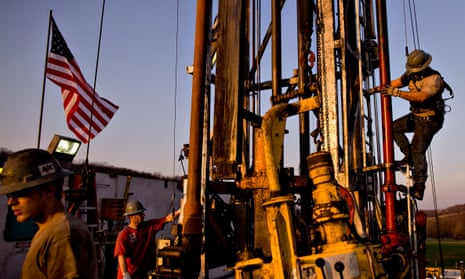The bankruptcy of Chesapeake, the pioneer of using fracking to mine shale gas and oil, could mark a new, straitened era for the oil industry, according to analysts.
The Oklahoma City-based company said on Sunday that it had been forced to enter chapter 11 protection to reduce the size of its debt pile from $9bn (£7.3bn) to $2bn. A grace period for paying bondholders had been due to expire on Tuesday.
Oil industry analysts said they expected more higher-cost and indebted shale companies to fold or be bought by competitors because of low oil and gas prices.
“The growth at all costs model is out the window,” said Robert Polk, an analyst at oil research company Wood Mackenzie.
Environmental campaigners said the bankruptcy highlighted the risks to investors holding shares in oil and gas companies that have previously prized growth above cash flow.
Jeanne Martin, the campaign manager at ShareAction, said the Chesapeake bankruptcy should serve as a “wake-up call” for banks including Barclays, Credit Suisse, Deutsche Bank and HSBC, which had continued to fund the fracking industry despite knowledge of their contribution to the climate crisis.
Fracking, also known as hydraulic fracturing, involves pumping water, chemicals and sand underground at high pressure to fracture shale rock and release trapped oil and gas.
Martin said: “Environmentalists have raised the alarm about the environmental disaster of fracking and the vulnerability of the fracking industry for years. Chesapeake’s bankruptcy flagrantly shows that these risks are no longer on the horizon, but at companies’ doorstep.”
US and Canadian energy firms have cut the number of oil and gas rigs operating to a record low, despite the slight increase in oil prices recently. The number of operating rigs in the US has fallen to only 265 by 26 June, down by more than 700 in the past 12 months, according to the oil data company Baker Hughes.
“No massive investments are likely to be made in the foreseeable future given the gigantic mountains of debt and the considerable financial risks,” said the Commerzbank analyst Eugen Weinberg.
Joachim Klement, an analyst at the stockbroker Liberum, said the lowest-cost oil producing nations such as Saudi Arabia and its partners in the oil cartel, the Organisation of Petroleum Exporting Countries, could act to keep prices at about $40 per barrel to heighten pressure on Russia.
“If that means that some unwanted competition from US shale oil producers will disappear as well, then that would just be a welcome side effect,” Klement wrote.
Companies such as QEP Resources, Highpoint Resources, Oasis Petroleum and Whiting Petroleum needed oil prices of $40 or even $50 per barrel to break even, Klement said. The price of a barrel of West Texas Intermediate oil for August delivery was just above $39 on Monday.
However, Wood Mackenzie and other analysts cautioned that the Chesapeake bankruptcy and the difficulties facing other companies were not terminal for the broader sector.
“There’s been less capital that will be deployed to the sector, but that doesn’t mean there’s going to be no capital,” Polk said.
